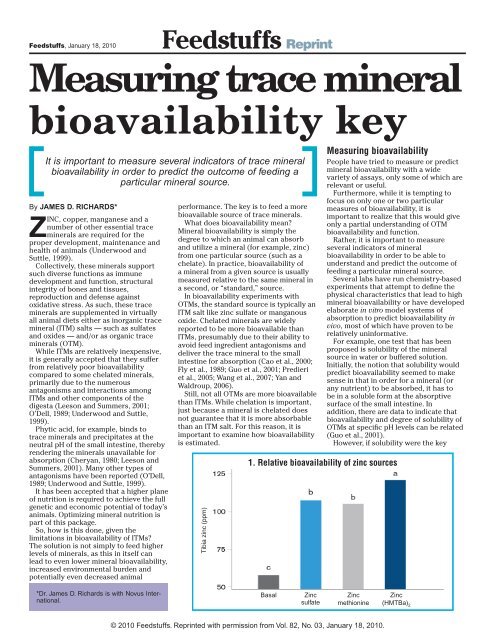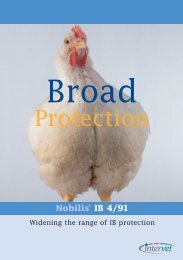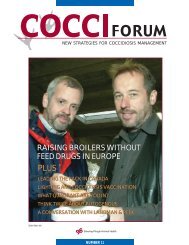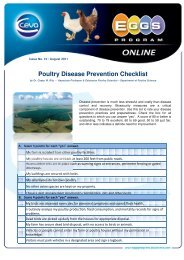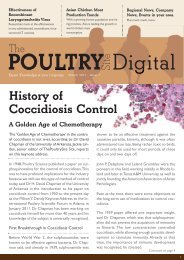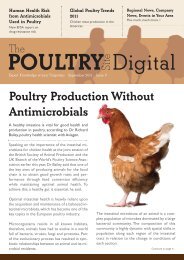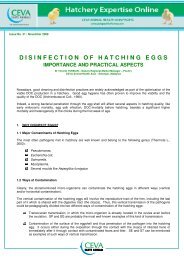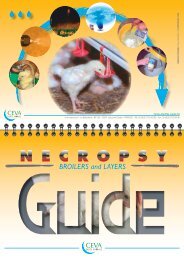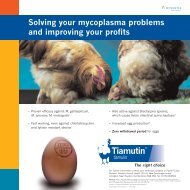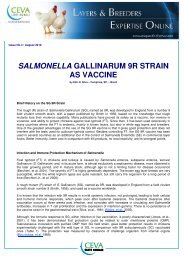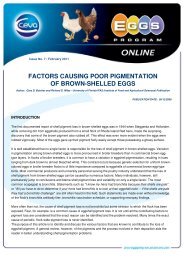Measuring trace mineral bioavailability key - The Poultry Site
Measuring trace mineral bioavailability key - The Poultry Site
Measuring trace mineral bioavailability key - The Poultry Site
You also want an ePaper? Increase the reach of your titles
YUMPU automatically turns print PDFs into web optimized ePapers that Google loves.
Feedstuffs, January 18, 2010Feedstuffs Reprint<strong>Measuring</strong> <strong>trace</strong> <strong>mineral</strong><strong>bioavailability</strong> <strong>key</strong>It is important to measure several indicators of <strong>trace</strong> <strong>mineral</strong><strong>bioavailability</strong> in order to predict the outcome of feeding aparticular <strong>mineral</strong> source.By JAMES D. RICHARDS*ZINC, copper, manganese and anumber of other essential <strong>trace</strong><strong>mineral</strong>s are required for theproper development, maintenance andhealth of animals (Underwood andSuttle, 1999).Collectively, these <strong>mineral</strong>s supportsuch diverse functions as immunedevelopment and function, structuralintegrity of bones and tissues,reproduction and defense againstoxidative stress. As such, these <strong>trace</strong><strong>mineral</strong>s are supplemented in virtuallyall animal diets either as inorganic <strong>trace</strong><strong>mineral</strong> (ITM) salts — such as sulfatesand oxides — and/or as organic <strong>trace</strong><strong>mineral</strong>s (OTM).While ITMs are relatively inexpensive,it is generally accepted that they sufferfrom relatively poor <strong>bioavailability</strong>compared to some chelated <strong>mineral</strong>s,primarily due to the numerousantagonisms and interactions amongITMs and other components of thedigesta (Leeson and Summers, 2001;O’Dell, 1989; Underwood and Suttle,1999).Phytic acid, for example, binds to<strong>trace</strong> <strong>mineral</strong>s and precipitates at theneutral pH of the small intestine, therebyrendering the <strong>mineral</strong>s unavailable forabsorption (Cheryan, 1980; Leeson andSummers, 2001). Many other types ofantagonisms have been reported (O’Dell,1989; Underwood and Suttle, 1999).It has been accepted that a higher planeof nutrition is required to achieve the fullgenetic and economic potential of today’sanimals. Optimizing <strong>mineral</strong> nutrition ispart of this package.So, how is this done, given thelimitations in <strong>bioavailability</strong> of ITMs?<strong>The</strong> solution is not simply to feed higherlevels of <strong>mineral</strong>s, as this in itself canlead to even lower <strong>mineral</strong> <strong>bioavailability</strong>,increased environmental burden andpotentially even decreased animalperformance. <strong>The</strong> <strong>key</strong> is to feed a morebioavailable source of <strong>trace</strong> <strong>mineral</strong>s.What does <strong>bioavailability</strong> mean?Mineral <strong>bioavailability</strong> is simply thedegree to which an animal can absorband utilize a <strong>mineral</strong> (for example, zinc)from one particular source (such as achelate). In practice, <strong>bioavailability</strong> ofa <strong>mineral</strong> from a given source is usuallymeasured relative to the same <strong>mineral</strong> ina second, or “standard,” source.In <strong>bioavailability</strong> experiments withOTMs, the standard source is typically anITM salt like zinc sulfate or manganousoxide. Chelated <strong>mineral</strong>s are widelyreported to be more bioavailable thanITMs, presumably due to their ability toavoid feed ingredient antagonisms anddeliver the <strong>trace</strong> <strong>mineral</strong> to the smallintestine for absorption (Cao et al., 2000;Fly et al., 1989; Guo et al., 2001; Predieriet al., 2005; Wang et al., 2007; Yan andWaldroup, 2006).Still, not all OTMs are more bioavailablethan ITMs. While chelation is important,just because a <strong>mineral</strong> is chelated doesnot guarantee that it is more absorbablethan an ITM salt. For this reason, it isimportant to examine how <strong>bioavailability</strong>is estimated.Tibia zinc (ppm)<strong>Measuring</strong> <strong>bioavailability</strong>People have tried to measure or predict<strong>mineral</strong> <strong>bioavailability</strong> with a widevariety of assays, only some of which arerelevant or useful.Furthermore, while it is tempting tofocus on only one or two particularmeasures of <strong>bioavailability</strong>, it isimportant to realize that this would giveonly a partial understanding of OTM<strong>bioavailability</strong> and function.Rather, it is important to measureseveral indicators of <strong>mineral</strong><strong>bioavailability</strong> in order to be able tounderstand and predict the outcome offeeding a particular <strong>mineral</strong> source.Several labs have run chemistry-basedexperiments that attempt to define thephysical characteristics that lead to high<strong>mineral</strong> <strong>bioavailability</strong> or have developedelaborate in vitro model systems ofabsorption to predict <strong>bioavailability</strong> invivo, most of which have proven to berelatively uninformative.For example, one test that has beenproposed is solubility of the <strong>mineral</strong>source in water or buffered solution.Initially, the notion that solubility wouldpredict <strong>bioavailability</strong> seemed to makesense in that in order for a <strong>mineral</strong> (orany nutrient) to be absorbed, it has tobe in a soluble form at the absorptivesurface of the small intestine. Inaddition, there are data to indicate that<strong>bioavailability</strong> and degree of solubility ofOTMs at specific pH levels can be related(Guo et al., 2001).However, if solubility were the <strong>key</strong>1. Relative <strong>bioavailability</strong> of zinc sources*Dr. James D. Richards is with Novus International.BasalZincsulfateZincmethionineZinc(HMTBa) 2© 2010 Feedstuffs. Reprinted with permission from Vol. 82, No. 03, January 18, 2010.
2Feedstuffs, January 18, 2010Reprintto <strong>bioavailability</strong>, then ITM salts wouldbe extremely bioavailable. Copper,manganese and zinc sulfates are allhighly soluble in water (CRC, 1981-82),yet they are not as bioavailable as ahigh-quality OTM. In fact, the majority ofdata show that there is little relationshipbetween <strong>mineral</strong> solubility and <strong>mineral</strong><strong>bioavailability</strong> (Guo et al., 2001; Ledoux etal., 1995; Miles et al., 1998).Some peer-reviewed data even suggestthat for zinc chelates, high solubility isinversely related to <strong>bioavailability</strong> in bothpoultry and ruminants (Cao et al., 2000).Thus, one should be cautious about usingsolubility — or any in vitro test — topredict the relative <strong>bioavailability</strong> of a<strong>trace</strong> <strong>mineral</strong> source.<strong>Measuring</strong> the deposition or storage of<strong>mineral</strong>s into selected tissues is the mostcommon output in <strong>trace</strong> <strong>mineral</strong> relative<strong>bioavailability</strong> experiments (Underwoodand Suttle, 1999).Figures 1 and 2 are from experimentsthat compared the relative <strong>bioavailability</strong>of zinc sources and manganese sources,respectively, by measuring tibia zincor manganese content. Figure 1 showsthat while all supplemented treatments(added at 40 parts per million of zinc)increased tibia zinc, zinc (HMTBa) 2(zinc chelated by two molecules of themethionine hydroxy analogue) was morebioavailable than the other two sources.Figure 2, which is from a slope-ratiodesign, demonstrates that manganese(HMTBa) 2 was about 150% as availableas the manganese from manganous oxide(Dibner, et al., 2004; Yan and Waldroup,2006).<strong>The</strong>se experiments support the notionthat certain chelated <strong>mineral</strong>s can bemore bioavailable than ITMs.Still, tissue <strong>mineral</strong> experimentshave some limitations. First, theseexperiments measure only a fraction ofthe <strong>mineral</strong> that is absorbed. Minerals areabsorbed by the small intestine and thendistributed via the bloodstream to othertissues. <strong>The</strong>refore, tissue <strong>mineral</strong> levelsonly measure the <strong>mineral</strong> distributed tothose particular tissues and, as such, maynot reflect total <strong>mineral</strong> uptake.A second limitation is that tissue<strong>mineral</strong> levels actually represent astorage pool of <strong>mineral</strong> rather thanthe total amount of <strong>mineral</strong> deliveredto that particular tissue. In general,tissue <strong>mineral</strong> stores can be altered as aconsequence of <strong>mineral</strong> excretion, useor stress (Underwood and Suttle, 1999).<strong>The</strong>refore, measuring tissue <strong>mineral</strong>s tellsonly part of the story. To truly measure<strong>bioavailability</strong>, it would be useful tomeasure <strong>mineral</strong> absorption in the smallintestine where absorption occurs.BiomarkersAnother method for estimating<strong>bioavailability</strong> is to measure <strong>mineral</strong>responsivebiomarkers, such as changesTibia manganese (ppm)Metallothionein mRNA (relative units)2. Relative <strong>bioavailability</strong> of manganese sourcesManganese oxideManganese (HMTBa) 2Supplemental manganese (ppm)3. Small intestinal metallothionein mRNA expressionas an indicator of zinc <strong>bioavailability</strong>ControlZincsulfatein gene expression, or the activity of a<strong>mineral</strong>-dependent enzyme. Biomarkersare particularly informative whenmeasured in the small intestine.Metallothionein is one such biomarker,because its expression is regulatedby zinc status; the magnitude ofmetallothionein messenger RNA (mRNA)and protein expression depends onthe amount of zinc absorbed (Davisand Cousins, 2000). <strong>The</strong>refore,metallothionein mRNA or proteinexpression is often used as an indicatorof the zinc status of humans and animalsand to evaluate the <strong>bioavailability</strong> ofdifferent zinc sources (Blanchard et al.,2001; Cao et al., 2002; Huang et al., 2009;Lu et al., 1990; Martinez et al., 2004;McCormick et al., 1981; Reeves, 1995;Rojas et al., 1995; Sullivan et al., 1998).Figure 3 shows an example of usingsmall intestinal metallothionein mRNAexpression as an indicator of zinc<strong>bioavailability</strong> (Richards et al., 2007;Richards et al., 2008b). In this experiment,broilers were fed control diets or dietsZincproteinateZinc aminoacid complexZinc(HMTBa) 2supplemented with 70 ppm zinc fromthe indicated sources. Because zincabsorption occurs in the small intestine,differences in metallothionein expressionhere would be expected to more closelyrepresent relative <strong>bioavailability</strong> thantissue zinc levels would.<strong>The</strong>se data are consistent withthe data in Figures 1 and 2 in thatthey demonstrate that some, but notall, chelated zinc sources are morebioavailable than inorganic zinc.Consistent with the other experiments,Zn(HMTBa) 2 was the most availablesource.<strong>Measuring</strong> tissue <strong>mineral</strong>s or <strong>mineral</strong>dependentbiomarkers can be the easiestand most straightforward measuresto generate a quantitative estimate of<strong>mineral</strong> <strong>bioavailability</strong>.Fundamental rolesWith that said, it is important not to stopthere. Zinc, copper and manganese playfundamental roles in the biochemistry
ReprintFeedstuffs, January 18, 20103of the cells of the animal, primarilyby serving as essential componentsof hundreds of cellular enzymes andtranscription factors (Underwood andSuttle, 1999).If <strong>trace</strong> <strong>mineral</strong>s are limiting in the diet,any of these processes can suffer.So, by supplementing diets with morehighly available forms of <strong>trace</strong> <strong>mineral</strong>s,a producer will more effectively “feed”these enzyme systems, which shouldtranslate into a wide variety of biologicalbenefits.Indeed, recent results with <strong>trace</strong><strong>mineral</strong>s chelated with HMTBa havedemonstrated benefits such as enhancedimmune function (Dibner, 2005), reducedincidence of tibial dyschondroplasia(Dibner et al., 2007; Richards et al., 2006)and footpad lesions (Richards et al.,2006), reduced leg abnormalities (varus,valgus, shaky leg) and increased bonebreaking strength (Ferket et al., 2009),reduced oxidative stress (Richards etal., 2008a) and improved performance(Ferket et al., 2009) even at lower levelsof <strong>trace</strong> <strong>mineral</strong> inclusion (manuscriptsubmitted).While measures such as these are nottraditionally considered to be indicatorsof <strong>trace</strong> <strong>mineral</strong> <strong>bioavailability</strong>, theycan and should be used to confirm theinformation gained from assessing morecustomary measures, such as tissue<strong>mineral</strong>s and genetic biomarkers.ConclusionsFeeding high-quality, high-<strong>bioavailability</strong><strong>trace</strong> <strong>mineral</strong>s is an important <strong>key</strong> tomaximizing the growth potential and wellbeingof production animals. Chelated<strong>mineral</strong>s have the potential to deliver<strong>trace</strong> <strong>mineral</strong>s more effectively to thetissues of the animal and, thus, to bettersupport the biochemical functions of theanimal’s cells and tissues.This, in turn, leads to a wide varietyof biological and performance benefits.Unfortunately, not all OTMs can dothis. Only by truly understandingthe structure and consistency of agiven OTM source and by rigorouslyinvestigating its <strong>bioavailability</strong> througha variety of methods can one be assuredof the predictability and consistencyof the animal’s responses to OTMsupplementation.Mineral <strong>bioavailability</strong> has beenestimated in a wide variety of ways thatvary greatly in their effectiveness. Ingeneral, techniques that rely on chemicalassays and in vitro methodology are oflimited utility and can be misleading.In contrast, in vivo methods can bevery reliable methods on which to basenutritional decisions.Finally, and perhaps most importantlyfor decision-making, we need to rely onnot only one but many different in vivotechniques for assessing <strong>trace</strong> <strong>mineral</strong>quality and <strong>bioavailability</strong>. Only when weexamine a variety of different readouts,including tissue <strong>mineral</strong> levels, <strong>mineral</strong>dependentbiomarkers and functionalassays, can we make well-informed,confident decisions about <strong>trace</strong> <strong>mineral</strong>supplementation.ReferencesBlanchard, R.K., J.B. Moore, C.L. Green and R.J.Cousins. 2001. Modulation of intestinal gene expressionby dietary zinc status: Effectiveness of cDNAarrays for expression profiling of a single nutrientdeficiency. Proc. Natl. Acad. Sci. 98:13507-13513.Cao, J., P.R. Henry, S.R. Davis, R.J. Cousins, R.D.Miles, R.C. Littell and C.B. Ammerman. 2002. Relative<strong>bioavailability</strong> of organic zinc sources based ontissue zinc and metallothionein in chicks fed conventionaldietary zinc concentrations. Anim. Feed Sci.Tech. 101:161-170.Cao, J., P.R. Henry, R. Guo, R.A. Holwerda, J.P.Toth, R.C. Littell, R.D. Miles and C.B. Ammerman.2000. Chemical characteristics and relative bioavialabilityof supplemental organic zinc sources forpoultry and ruminants. J. Anim. Sci. 78:2039-2054.Cheryan, M. 1980. Phytic acid interactions in foodsystems. Crit. Rev. Food Sci. Nutr. 13:297-335.CRC. 1981-82. CRC Handbook of Chemistry &Physics, 62 ed. CRC Press Inc., Boca Raton, Fla.Davis, S.R., and R.J. Cousins. 2000. Metallothioneinexpression in animals: A physiological perspectiveon function. J. Nutr. 130:1085-1088.Dibner, J.J. 2005. Early nutrition of zinc andcopper in chicks and poults: Impact on growth andimmune function. Paper presented at Mid-AtlanticNutrition Conference. University of Maryland, CollegePark.Dibner, J.J., J.D. Richards, M.L. Kitchell and M.A.Quiroz. 2007. Metabolic challenges and early bonedevelopment. J. Appl. Poult. Res. 16:126-137.Dibner, J.J., M.L. Trehy, C.S. Schasteen andJ.A. Hume. 2004. Use of 2-hydroxy-4(methylthio)butanoic acid (HMTBa) as a ligand for organic <strong>trace</strong><strong>mineral</strong>s. Poult. Sci. 83 (supp. 1):436.Ferket, P.R., E.O. Oviedo-Rondon, P.L. Mente,D.V. Bohorquez, A.A. Santos Jr., J.L. Grimes, J.D.Richards, J.J. Dibner and V. Felts. 2009. Organic<strong>trace</strong> <strong>mineral</strong>s and 25-hydroxycholecalciferol affectperformance characteristics, leg abnormalities andbiomechanical properties of leg bones of tur<strong>key</strong>s.Poult. Sci. 88:118-131.Fly, A.D., O.A. Izquierdo, K.R. Lowry and D.H.Baker. 1989. Manganese <strong>bioavailability</strong> in a Mnmethioninechelate. Nutr. Res. 9:901-910.Guo, R., P.R. Henry, R.A. Holwerda, J. Cao,R.C. Littell, R.D. Miles and C.B. Ammerman. 2001.Chemical characteristics and relative <strong>bioavailability</strong>of supplemental organic copper sources for poultry.J. Anim. Sci. 79:1132-1141.Huang, Y.L., L. Lu, S.F. Li, X.G. Luo and B.Liu. 2009. Relative bioavailabilities of organic zincsources with different chelation strengths for broilersfed a conventional corn-soybean meal diet. J. Anim.Sci. 87:2038-2046.Jacob, C., W. Maret and B.L. Vallee. 1998. Controlof zinc transfer between thionein, metallothioneinand zinc proteins. Proc. Natl. Acad. Sci. 95:3489-3494.Ledoux, D.R., E.B. Pott, P.R. Henry, C.B. Ammerman,A.M. Merritt and J.B. Madison. 1995. Estimationof the relative <strong>bioavailability</strong> of inorganic coppersources for sheep. Nutr. Res. 12:1803-1813.Leeson, S., and J.D. Summers. 2001. Scott’sNutrition of the Chicken, 4th ed. University Books,Guelph, Ont.Lu, J., G.F. Combs Jr. and J.C. Fleet. 1990. Timecoursestudies of pancreatic exocrine damageinduced by excess dietary zinc in the chick. J. Nutr.120:389-397.Martinez, M.M., G.M. Hill, J.E. Link, N.E. Raney,R.J. Tempelman and C.W. Ernst. 2004. Pharmacologicalzinc and phytase supplementation enhancemetallothionein mRNA abundance and protein concentrationin newly weaned pigs. J. Nutr. 134:538-544.McCormick, C.C., M.P. Menard and R.J. Cousins.1981. Induction of hepatic metallothionein byfeeding zinc to rats of depleted zinc status. Am. J.Physiol. 240:E414-E421.Miles, R.D., S.F. O’Keefe, P.R. Henry, C.B. Ammermanand X.G. Luo. 1998. <strong>The</strong> effect of dietarysupplementation with copper sulfate or tribasic copperchloride on broiler performance, relative copper<strong>bioavailability</strong> and dietary prooxidant activity. Poult.Sci. 77:416-425.O’Dell, B.L. 1989. Mineral interactions relevant tonutrient requirements. J. Nutr. 119:1832-1838.Predieri, G., L. Elviri, M. Tegoni, I. Zagnoni, E.Cinti, G. Biagi, S. Ferruzza and G. Leonardi. 2005.Metal chelates of 2-hydroxy-4-methylthiobutanoicacid in animal feeding, Part 2: Further characterizations,in vitro and in vivo investigations. J. Inorg.Biochem. 99:627-636.Reeves, P.G. 1995. Adaptation responses in ratsto long-term feeding of high-zinc diets: Emphasis onintestinal metallothionein. J. Nutr. Biochem. 6:48-54.Richards, J.D., C.A. Atwell, P. Winkelbauer, C.W.Wuelling, M.E. Wehmeyer and J.J. Dibner. 2008a.MINTREX Organic Trace Minerals are more bioavailableand support the antioxidant response morethan other <strong>trace</strong> <strong>mineral</strong> forms. <strong>Poultry</strong> ScienceAssn. annual meeting, Niagara Falls, Ont.Richards, J.D., C.A. Atwell, C.W. Wuelling andM.E. Wehmeyer. 2007. A real time polymerase chainreaction assay for metallothionein to measure <strong>bioavailability</strong>of zinc sources for broilers. International<strong>Poultry</strong> Scientific Forum, Atlanta, Ga.Richards, J.D., J.J. Dibner, P. Winkelbauer, C.A.Atwell, M.A. Quiroz, T. York, J. Zhou, R. Shirley,A.F. Giesen and C.D. Knight. 2008b. Organic <strong>trace</strong><strong>mineral</strong>s for poultry enhance <strong>mineral</strong> <strong>bioavailability</strong>and can improve performance and reduce environmentalimpact. XXXIII World’s <strong>Poultry</strong> Conference,Brisbane, Australia.Richards, J.D., M. Quiroz, W. Williams and J.J.Dibner. 2006. Benefit of MINTREX P blend of organic<strong>trace</strong> <strong>mineral</strong>s on breaking strength, ash content,tibial dyschondroplasia, synovitis and pododermatitisin heavy-weight tom tur<strong>key</strong>s. <strong>Poultry</strong> ScienceAssn. annual meeting, Edmonton, Alb.Rojas, L.X., L.R. McDowell, R.J. Cousins, F.G.Martin, N.S. Wilkinson, A.B. Johnson and J.B. Velasquez.1995. Relative <strong>bioavailability</strong> of two organicand two inorganic zinc sources fed to sheep. J.Anim. Sci. 73:1202-1207.Sullivan, V.K., F.R. Burnett and R.J. Cousins.1998. Metallothionein expression is increased inmonocytes and erythrocytes of young men duringzinc supplementation. J. Nutr. 128:707-713.Underwood, E.J., and N.F. Suttle. 1999. <strong>The</strong> <strong>mineral</strong>nutrition of livestock, 3rd ed. CABI Publishing,New York, N.Y.Wang, Z., S. Cerrate, C. Coto, F. Yan and P.W.Waldroup. 2007. Evaluation of Mintrex Copper asa source of copper in broiler diets. Int. J. Poult. Sci.5:308-313.Yan, F., and P. Waldroup. 2006. An evaluationof MINTREX organic <strong>trace</strong> <strong>mineral</strong> as a source ofmanganese in broiler diets. International <strong>Poultry</strong>Scientific Forum, Atlanta, Ga. ■


